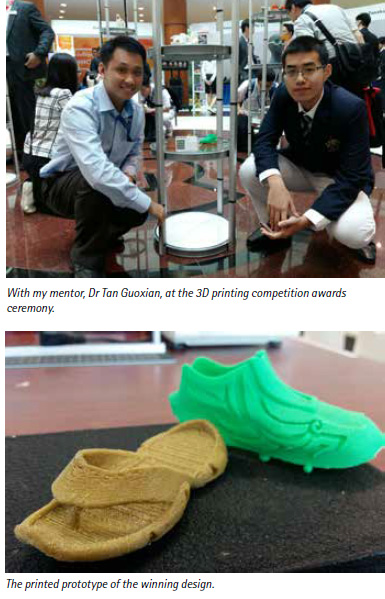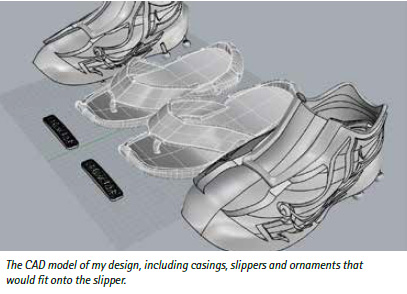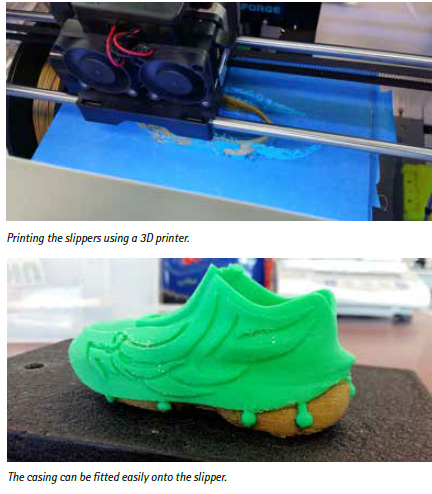|
by Wang Heng
 3D printing, also known as additive manufacturing (AM), refers to various processes used to synthesize a three-dimensional object. It is believed by some futurologists to be the technology that will start the next Third Industrial Revolution. Such claims are by no means far-fetched by virtue of 3D printing having a promising propensity to improve customization of products, as well as the means to increase the mobility of products. The potential of 3D printing allows one to significantly reduce the cost of production by cutting down wastage of materials. Even in Singapore, 3D printing technology has been applied across a wide range of high-end fields including but not limited to, aerospace, defense, construction and biomedical production.
3D printing, also known as additive manufacturing (AM), refers to various processes used to synthesize a three-dimensional object. It is believed by some futurologists to be the technology that will start the next Third Industrial Revolution. Such claims are by no means far-fetched by virtue of 3D printing having a promising propensity to improve customization of products, as well as the means to increase the mobility of products. The potential of 3D printing allows one to significantly reduce the cost of production by cutting down wastage of materials. Even in Singapore, 3D printing technology has been applied across a wide range of high-end fields including but not limited to, aerospace, defense, construction and biomedical production.
In April 2016, the Singapore Centre for 3D Printing (SC3DP) organized the fourth run of the Singapore International 3D Printing Competition. This competition is organized in hope of raising common awareness about 3D printing technology. This will facilitate and enable the sharing of knowledge among different countries while inspiring the younger generation to be involved in the pursuit and research of such technology, thereby offering innovative solutions to the industry in the future. As a novice individual who has just started his exploration in the world of 3D printing, and a student who was fortunately awarded in this competition, I would like to share more about the journey and my understanding of the world through 3D printers.
Genesis
My interest in crafting began from childhood. Back in kindergarten, my favorite anime character was Doraemon, a blue robot with a magical pocket which contains tonnes of interesting props. Often, I dreamt about having such a fascinating bottomless pit of a pocket, so that I would be able to solve any problem I was facing and have all my wishes become reality. While spending a significant amount of my free time watching Doraemon anime, I too attempted to use sketch-boards and pencils to create something more impressive, functional and cool than the knick-knacks being pulled out from the pocket of Doraemon. I was not a good artist, but sketching three-dimensional objects, fortunately, was not mission impossible.

Sometimes, I would try to realize my designs, such as building handheld cannons from cardboard, or making small parachutes out of plastic bags. However, the more I attempted to create, the more I realized that most of the props in the Doraemon show were unrealistic, not only because we humans do not have the means to create them, but also because these props simply do not obey the laws of classical Physics. I mean, how could a pen-sized airscrew create sufficient thrust to support the weight of a person?
That was also the time when I first heard of 3D printing technology on a midnight radio channel. At first, the idea hit me the same way any of the Doraemon's props struck me & #8212; I could not believe such printers actually existed. How could it be possible to click on the computer, and watch a mere printer churn out a car, a telephone or even canned food?
The first time I actually saw 3D printers was in a Jackie Chan movie titled "Chinese Zodiac 12". In the movie, Jackie Chan used the 3D scanner in-built in his glove to create the 3D model of the bronze head of the Chinese zodiac and successfully printed identical replicas with 3D printers. The idea of being able to create exact replicas fascinated me no end and I was hooked — 3D printing technology was real and possible!
Starting Off
It surprised me when I realized that my school would be sending students' work to the Singapore International 3D Printing Competition. Nonetheless, I was excited at this possibility, not only because there was finally a chance for me to further pursue my interest in designing, but also because I realized that 3D printers were now within my reach, and I would have a chance to actually operate the machines! The competition would perhaps be a great opportunity for me to pursue my passion for Physics and to hone my inner creativity in designing a pair of shoes that are comfort-fit, innovatively snazzy and quintessentially marketable. The competition requirements were rather demanding, given that the experience of comfort in shoe-wearing and the aesthetically fancy appearance expected of statement-making shoes might not naturally co-exist. It isn't very hard to find an aesthetically pleasing 3D-printed high heel online nowadays, but improving the functionality and marketability of such shoes could be a challenge, in my analysis. In addition, ABS (acrylonitrile butadiene styrene) and PLA (polylactic acid) are the common materials used for printing such high-heeled shoes. Imagine wearing purely plastic high-heeled shoes with hard plastic-like materials constantly rubbing against your feet. Well, I doubt the experience would be a comfortable one at all!
After much consideration, I decided to drop the idea of creating a fanciful high heel and use soft, flexible material, TPU (thermoplastic polyurethane), instead of ABS or PLA. I am extremely grateful to my teacher-mentor, Dr Tan Guoxian, who provided the participants with a series of workshops that allowed us to better understand the theory of this technology, the type of printers available in the school and their limitations. He also discussed with me the ideas I thought of, and helped me evaluate the feasibility of these ideas.

The Inspiration
I took me some time to make up my mind on the type of shoes I was going to create. The creator of the prototype system of STL (STereoLithography) 3D printing technology, Chuck Hull, defined the process of 3D printing as "a system for generating three-dimensional objects by creating cross-sectional patterns of the objects to be formed". Similarly, the printers in my school use the FDM (fused deposition modelling) technique, which involves melting solid materials and extruding them using a movable extruder to create horizontal layers, which then quickly solidify and eventually form an object.
Since the 3D objects were created layer by layer, it meant that overhanging features would require supports to be printed along the way as well, so as to prevent inclement collapses. As such, I was advised not to print a pair of sports shoes as the enclosed structure would make the removal of supporting structures almost impossible.
After weeks of observing people's footwear on the streets and browsing through copious pages of shoe designs, my eyes finally fell upon the concept of creating a pair of slippers. In 34oC Singapore climate, slippers are ubiquitous footwear, keeping feet protected and offering wearers quick slip-ons when going out for casual purposes. It is, however, not hard to see that challenges exist for designing slippers that are both functional and sartorially-pleasing, especially in the fashion-conscious culture of today. Every novel design, no matter how fabulous, will not stay trendy forever, as fashion is always in a constant state of dynamic flux and change. As such, I was inspired to make slippers that would evolve over time, offering comfort and ease to wearers as well as unlimited upgrading potential. In addition, by separating the casing and the base, I avoided the problems of having excessive irremovable supporting structures.
Changeable casings would allow for diversity through transforming slippers into shoes as the occasion required. The disruptive change principle is thus applied in how we view footwear as being able to provide two-in-one solutions. People can simply wear the slippers out, or give them new looks by adding the casings. This enables them to define their personal styles as well as simultaneously enjoying the comfort of their favorite slippers. When customers grow tired of the old designs, they could "upgrade" by looking for brand-new designs which would be available in the market. The personalization of designs can be easily achieved using 3D printing technology and programmable, user-friendly software - and all at low cost! This idea of customization would best showcase the potential of 3D printing.
The Challenge Faced
After the brainstorming process, there were still two main procedures in the crafting process, namely modeling and printing. Firstly, 3D printable models would be created with computer-aided design (CAD) software, and then saved in the form of STL files, which must first be examined for errors before printing. In fact, most of the CAD software produced errors in the STL files including holes, faces normal, self-intersections, noise shells or manifold errors. This step is called "repair", as the original model needs to be fixed. Once completed, the STL file would be processed by a piece of software called a "slicer", which converts the model into a series of thin layers and produces a G-code file containing instructions tailored to a specific type of 3D printer (FDM printers). This G-code file can then be printed with 3D printing client software.
After I had sketched the design, I then built my model accordingly using Rhinoceros, a modeling software, through a series of line-building, "blend surface", "sweep2" and "Boolean operations". The slippers, casing and ornament were then saved separately in binary STL files and printed using FDM printers, after conversion into G-code document. The process might sound easy, but when I got down to it, I found that it was hardly a simple task.
One of the problems I faced was the faulty STL files caused by numerous gaps in the model I built. Due to lack of experience and consideration at times, I chose the wrong tools while operating the Rhinoceros which resulted in a non-water tight object being created, thus not being loaded by the slicing software. The process of rebuilding and filling the gap was not only boring but extremely tedious; sometimes the gap might only require blending and adjustment of angles, but I might end up having to rebuild the entire structure. Fortunately, with strong determination and a burning desire to see the realization of the shoes, I rose up to the challenge.
This was, however, not the end of all hardships. The printer used was a dual-head FDM printer, with one TPU extruder and another extruder containing another material. This dual-print technique was crucial because printing the support structure in TPU alone posed difficulty in separation (which was done on the first try). However, when a water-soluble material (PVA) is used, TPU adhered poorly to the PVA support structure, resulting in the collapse of the prints. Hence, I had no choice but to use PLA as the support structure material, which required time to be mechanically removed. A power-base technique such as 3DP or SLS would be a better solution to this problem if the slippers are to be manufactured and sold in the market.
The Outcome
After all the painstaking trials and errors, trouble-shootings and rectifications, a pair of slippers were successfully printed.
The slippers were 3D-printed using TPU, achieving a soft, cool-dry texture. There was also a rectangular block with words that could be glued onto the slippers, acting like a stamp, which left imprints on the ground on rainy days. This allowed customization of the slippers. Wearers could have their names printed within five minutes upon purchase of the slippers. Spherical slots around the casing allowed it to be fitted easily onto the slippers.
For its innovative concept and perhaps greater relevance and functionality, the slippers were selected as the winning design. But this is not all there is to my success story; the competition is not merely a platform for people to gain recognition, but also a chance for every participant to better appreciate the value and potential of this new technology and most definitely, see rooms for improvement. My journey in getting to grips with 3D printing probably does not end just here, for I fervently believe that there will be breakthroughs and wider applications of this technology in the future. The experience of this competition has allowed me to see the world with 3D printers, the world with better products and full efficiency, where anyone can be a creator and everyone can own his or her factory at home.
Conclusion
I named my design "Evo-Slip 4U", which builds on the idea that slippers can constantly change to fit the wearer's personality and interests, which is in constant flux and evolution. With the same idea, the prototype casing I have designed depicts a winged pattern symbolizing the winged sandals worn by the fleet-footed Roman god Mercury on his feet. It illustrates the idea of soaring forward and upward to constantly improve dynamically to achieve optimal outcomes and arrive at new destinations after undertaking different journeys of discovery, wonder and innovation. This is not simply a narrative about the footwear per se but is about 3D printing technology, its amazing past inception, its mind-blowing present-day ramifications and its promising future possibilities.
Wang Heng is a final year student at Raffles Institution. Besides clinching the top prize in the Singapore International 3D Printing Competition, he is the winner of the 2016 Singapore Space Challenge. Apart from his passion for design and engineering, he also finds joy in reading, reviewing movies and acting on stage. He believes that life is the best source of inspiration and the genesis of every great invention.
For more information about this article, please contact Mr Wang Heng at wang1hen1g@gmail.com
 Click here to download the full issue for USD 6.50 Click here to download the full issue for USD 6.50
|


 3D printing, also known as additive manufacturing (AM), refers to various processes used to synthesize a three-dimensional object. It is believed by some futurologists to be the technology that will start the next Third Industrial Revolution. Such claims are by no means far-fetched by virtue of 3D printing having a promising propensity to improve customization of products, as well as the means to increase the mobility of products. The potential of 3D printing allows one to significantly reduce the cost of production by cutting down wastage of materials. Even in Singapore, 3D printing technology has been applied across a wide range of high-end fields including but not limited to, aerospace, defense, construction and biomedical production.
3D printing, also known as additive manufacturing (AM), refers to various processes used to synthesize a three-dimensional object. It is believed by some futurologists to be the technology that will start the next Third Industrial Revolution. Such claims are by no means far-fetched by virtue of 3D printing having a promising propensity to improve customization of products, as well as the means to increase the mobility of products. The potential of 3D printing allows one to significantly reduce the cost of production by cutting down wastage of materials. Even in Singapore, 3D printing technology has been applied across a wide range of high-end fields including but not limited to, aerospace, defense, construction and biomedical production.


 Click here to download the full issue for USD 6.50
Click here to download the full issue for USD 6.50